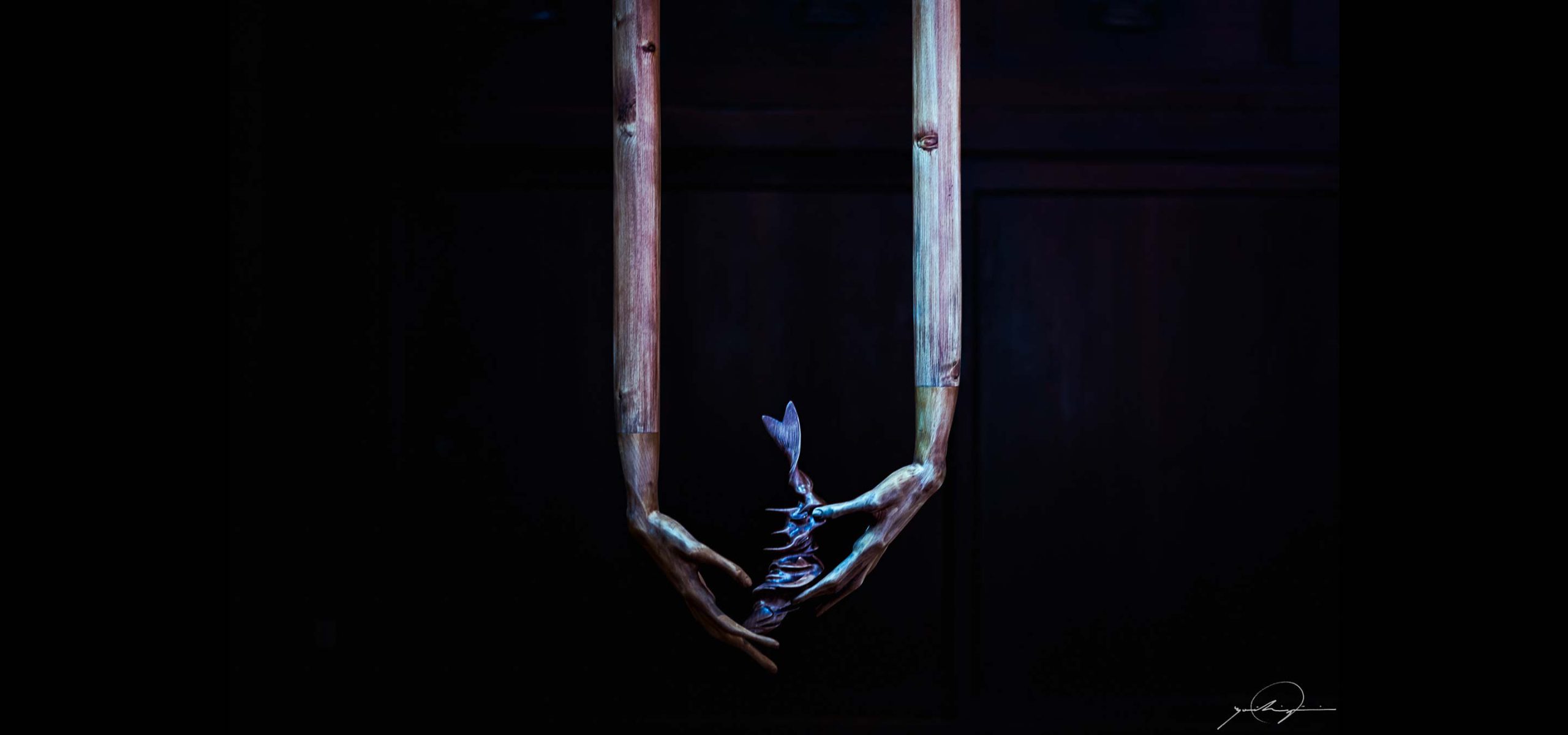

Sculpture
2022


これらの作品は高山の技巧性の高い手の技を持つ木工作家(伊藤さん・村瀬さん・山内さん)とのラボレーションによって製作された.原型はカリモク家具株式会社の支援によって作家の製作する3D データから木材の削り出しを行った.手長足長は,中国の古典山海経の中でそれぞれ手の長い長臂人(長臂国の人),足の長い長股人(長股国の人)として登場する人々を起源とすると言われている.足の長い長股人が手の長い長臂人を背負って魚を捕るという伝説もある.その姿は日本に伝来し,でいだらぼっちなどの巨人の妖怪や,蛸をとる妖怪など多様な形に姿を変え,伝承として保存されている. 八岐大蛇に捧げられる稲田姫の両親はテナヅチ,アシナヅチであるし,手長神社と足長神社が長野にあるのも,そういった手長足長の派生となんらかの関係がみられるのかもしれない.これらのサーベイを行なっていたとき,狩猟採集そして山と森の文化の結節点の一つとして手長足長があるのかもしれないと考えた.もとより,飛騨高山や諏訪など中部一帯では縄文時代の遺跡が多く出土する.これが裏付けるように一万年以上に亘る豊かな狩猟採集社会が持続したことが遺跡調査からも明らかであり,農耕に移行する必然性を持たない地域も多く存在したのではないか.前項の稲田姫もそうだが,多くの日本神話の神は農耕社会から必然的に生まれうる神である.テナヅチアシナヅチはオオヤマツミの子を名乗るが,オオヤマツミやカヤノヒメはその名の通り,山の神・野と草の神であり国産み神話における地形の意味する精霊的な要素が強いのだろう.その文脈から縄文・狩猟採集社会における超人性やその環境に適応した人の形を意味するように思っている.伝承で描かれるような手長足長の描く巨人の身体性は山を跨ぐ移動の身体性や遠くの木々や果実や生き物に手が届くような採集の願望を表現しているように感じられる.地域性・風土性・そして民藝を考えたとき,手長足長のように身体感覚を惹起し文化を通底するものをメインモチーフにすることをテーマにしようと考えた.日下部民藝館の木組みの広い伝統建築が持つ空間には空想上の余裕がある.それが空間の持つ豊かさであると思う.その余裕の中から手が伸び足が伸びてくる.ひょっとしたらあなたの背中をさするかもしれないし,鮎を捏ねて宙に浮かべてしまうかもしれない.現代の「定在する遊牧民」の足は長く,手も長く,計算機の自然は空間と時間を交錯させ,あらゆるところにあらゆるものを変換し顕現させていくのかもしれない.
These works were produced in collaboration with Shinjiro Ito, Kyohei Murase, and Hirotoshi Yamauchi, the woodworkers of Hida Takayama who are highly skilled in their craft. The model was cut out from a block of wood using 3D data produced by Ochiai with the support of Karimoku Furniture Co. (Special thanks to Myuna Komurai.) It is said that the Tenaga and Ashinaga figures originated from the Chinese text Shan Hai Jing (Classic of Mountains and Seas) which describes the "longarmed people'' and the "long-legged people," respectively.
Legend has it that long-legged people carried the longarmed people on their backs to catch fish. These figures were introduced to Japan and have been preserved as folklore, taking on various forms, such as Deidarabotchi, the giant yokai (monster), and a yokai which feasts on octopuses. In Japanese mythology, the parents of the Inadahime deity, who is offered to the eight-forked serpent, Yamata-no Orochi, are Tenazuchi (arm deity) and Ashinazuchi (leg deity). The existence of the Tenaga Shrine (long-arm shrine) and Ashinaga Shrine (longleg shrine) in Nagano may also have something to do with the derivation of the Tenaga and Ashinaga forms.
While conducting surveys on the Tenaga and Ashinaga, it occurred to Ochiai that the concept of these figures may express the connection between hunting and gathering, and mountain and forest culture in Japan. Many remains from the Jomon period have been excavated in the central region of Japan, including Hida Takayama and Suwa. As evidenced by the archaeological findings indicating that a rich hunter-gatherer society persisted for more than 10,000 years, there may have been many areas that did not require the shift to agriculture.
Like the Inadahime deity mentioned in the previous section, many of the deities of Japanese mythology are inevitably born out of an agricultural society. Tenazuchi (arm deity) and Ashinazuchi (leg deity) claim to be the children of Oyamatsumi (great mountain deity) and Kayanohime (grass deity), who are, as their names suggest, gods of the mountains, fields and grass. There is also a strong spiritual element in the meaning of the landform in Kuniumi, the ancient mythology on the birth of the nation. In this context, Ochiai believes that the Tenazuchi and Ashinazuchi figures refer to the superhumanity of the Jomon and hunter-gatherer societies and that they depict the human form which adapted to the environment.
The physical qualities of the giants depicted in folklore, with their long arms and long legs, seem to express the will of wanting to move across mountains and the desire to forage, to reach distant trees, fruits, and creatures.
When Ochiai thought about regionality, locality, and folk art, he decided to use Tenazuchi and Ashinazuchi as the main motif as they are a part of Hida’ s culture and figures that evoke awareness of the physical existence.
The spacious traditional wooden structure of the Kusakabe Folk Crafts Museum gives off an abstract sense of space. Ochiai believes this sense is the richness of space. Long arms and feet may stretch out from the large-scale room, and perhaps they will rub your back, or knead a sweetfish and let it float in the air. The arms and feet of today's "stationary nomads" are long, and the digital nature may intersect space and time, transforming and manifesting everything everywhere.
物象化する願い, 変換される身体(手長)へのお問い合わせは、当サイトのContactページのフォームよりお問い合わせください。
For inquiries about Materialization of Hope, Transformation of Body (Tenaga), please use the form on the Contact page of this site.